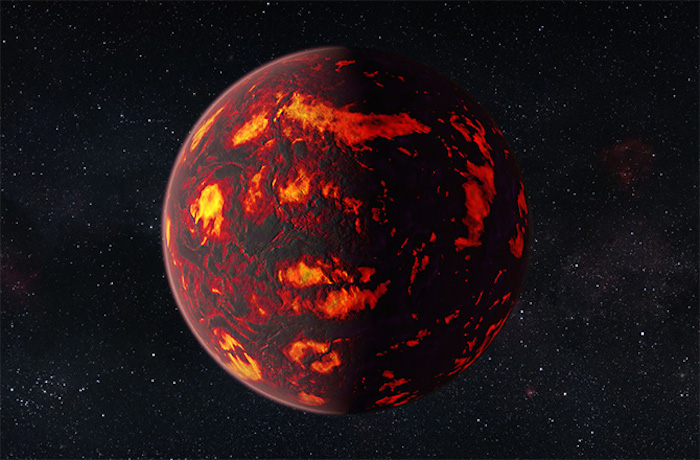.

For the first time, a super-Earth’s atmosphere has been analyzed — but don’t make any vacation plans to visit. The planet is blisteringly close to its planet star (exhibiting temperatures of 3,600 Fahrenheit or 2,000 Celsius) and has an atmosphere mostly made up of hydrogen and helium, like a gas giant planet.
Hydrogen and helium are common elements in young solar systems as those are the elements that make up young stars. Typically, however, smaller planets tend to lose the hydrogen and helium over time into space because their gravity is so low; the light elements escape, especially if a star’s radiation pushes against the atmosphere. Gas giant planets can hold on to those elements due to their stronger gravity.
On small planets, sometimes the hydrogen/helium atmosphere is replaced by a secondary atmosphere, which was the case on Earth. Our current mix of nitrogen, oxygen and carbon dioxide likely came from internal processes (such as volcanism) and the evolution of plants.“We did not expect 55 Cancri e to retain this much of its primordial gas atmosphere,” said Ingo Waldmann, a post-doctoral research assistant at University College London who participated in the research, in an e-mail to Discovery News. Waldmann pointed out that the planet is the only known super-Earth with such a high temperature, but the astronomers had thought it would lose most of its atmosphere due to the intense radiation of its parent star. Why it held on to the hydrogen and helium is poorly understood.Astronomers have a few sample measurements of planetary atmospheres from outside our solar system, but these are from gas giants that are easier to spot in telescopes. As the large planet passes across the face of its planet star, the elements detected in a telescope change slightly. That change is believed to represent the atmosphere of the planet.
The team decided to try for a smaller planet, but one that was orbiting a bright star to make it easier to distinguish the atmosphere of the planet from the elements in its parent star. A strong candidate for this work was the Hubble Space Telescope’s Wide Field Camera 3, which was installed by astronauts in 2009 and usually is used to track star or galaxy formation.
“The WFC3 camera on Hubble is a very sensitive instrument, not initially designed to observe bright stars, and the instrument would overexpose like your cell-phone camera held towards the sun would,” Waldmann said. “In 2012, the scanning mode was introduced to address this. Essentially we now quickly move Hubble across the star and ‘smear’ the spectrum across the detector. This helps the overexposure issue, but makes the data analysis very difficult.”
An additional challenge came from 55 Cancri e’s close distance. It is orbiting a sun-like star that is only about 40 light-years away. Because the star is so bright, Waldmann said, the scan speed had to be much faster than what was used before. The team studied the situation and developed a method that can extract a viable signal from the data, a signal that was strong enough to detect elements in the small planet’s atmosphere.
“If we can do this with Hubble, we are very confident that we can significantly improve with future instruments,” Waldmann said, pointing to the future James Webb Space Telescope (JWST), Transiting Exoplanet Survey Satellite (TESS) and PLAnetary Transits and Oscillations of stars (PLATO) telescope as examples. “These next-generation facilities will blow the field of exoplanet spectroscopy wide open and allow insight that, to date, we cannot even imagine. In other words, we really are on the threshold of taking planetary science from our solar system into the galaxy.”
Waldmann said the researchers have two future directions for research: to look at super-Earth atmospheres more broadly, and also to do follow-up observations of 55 Cancri e. There appear to be hints of hydrogen cyanide in the atmosphere, but to confirm this they will need a telescope such as JWST, which can observe in longer wavelengths of light than Hubble.
Quelle: D-News
4340 Views
